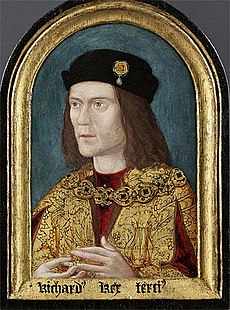Richard III, King of England
| Richard III | |
|---|---|

The earliest surviving portrait of Richard (c. 1520, after a lost original), formerly belonging to the Paston family
(Society of Antiquaries, London) |
|
| King of England (more...) | |
| Reign | 26 June 1483 – 22 August 1485 |
| Coronation | 6 July 1483 |
| Predecessor | Edward V |
| Successor | Henry VII |
| Born |
2 October 1452 Fotheringhay Castle, Northamptonshire |
| Died | 22 August 1485 (aged 32) Bosworth Field, Leicestershire |
| Burial | Greyfriars, Leicester (originally) Leicester Cathedral (re-interred, 26 March 2015) |
| Spouse | Anne Neville |
| Issue |
Edward of Middleham John of Gloucester (illegitimate) Katherine (illegitimate) |
| House | York |
| Father | Richard, 3rd Duke of York |
| Mother | Cecily Neville |
| Religion | Roman Catholic |
| Signature |  |
Richard III (2 October 1452 – 22 August 1485) was King of England from 1483 until his death in 1485, at the age of 32, in the Battle of Bosworth Field. He was the last king of the House of York and the last of the Plantagenet dynasty. His defeat at Bosworth Field, the last decisive battle of the Wars of the Roses, marked the end of the Middle Ages in England. He is the subject of the historical play Richard III by William Shakespeare.
When his brother King Edward IV died in April 1483, Richard was named Lord Protector of the realm for Edward's eldest son and successor, the 12-year-old Edward V. Arrangements were made for Edward's coronation on 22 June 1483; but, before the young king could be crowned, the marriage of his parents was declared bigamous and therefore invalid, making their children officially illegitimate and thus barring them from inheriting the throne. On 25 June, an assembly of Lords and commoners endorsed a declaration to this effect and proclaimed Richard the rightful king. The following day, Richard III began his reign, and he was crowned on 6 July 1483. The young princes, Edward and his younger brother Richard, Duke of York, were not seen in public after August, and accusations circulated that the boys had been murdered on Richard's orders.
There were two major rebellions against Richard. The first, in October 1483, was led by staunch allies of Edward IV and Richard's former ally, Henry Stafford, 2nd Duke of Buckingham; but the revolt collapsed. In August 1485, Henry Tudor and his uncle, Jasper Tudor, led a second rebellion. Henry Tudor landed in southern Wales with a small contingent of French troops and marched through his birthplace, Pembrokeshire, recruiting soldiers. Henry's force engaged Richard's army and defeated it at the Battle of Bosworth Field in Leicestershire. Richard was struck down in the conflict, making him the last English king to die in battle. Henry Tudor then ascended the throne as Henry VII.
...
Wikipedia
